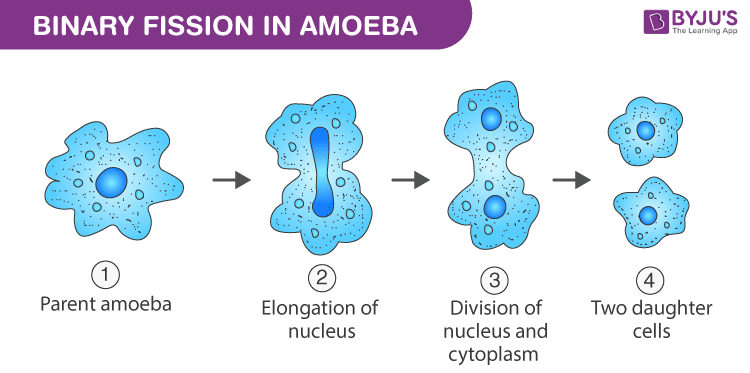One of the basic characteristics exhibited by living entities is the reproduction. It is a process in which organisms produce more of its kind by passing genetic information. The process can either involve two parents or a single organism can reproduce individually, hence there as two types of reproduction, asexual reproduction, and sexual reproduction.
Asexual reproduction is the process wherein a new offspring is produced without gamete formation. In sexual reproduction, both female and male gametes are involved. Asexual reproduction is commonly observed in lower animals and lower plants. New organisms are produced rapidly and are genetically identical to their parents.
Asexual reproduction can be of different types, namely:
- Budding
- Binary fission
- Multiple fission
- Fragmentation
- Sporulation
- Vegetative propagation
Aim
To study about (a) Binary Fission in amoeba and (b) Budding in yeast with the help of prepared slides
Principle/Theory
Budding and binary fission are types of asexual reproduction observed in lower organisms such as bacteria, unicellular protozoans and some other entities.
What is binary fission?
In this type of reproduction, the parent cell divides or is split into two daughter cells through mitosis wherein each daughter cell develops into an adult. Amitosis is the division of the nucleus.
Define budding?
It is a kind of asexual reproduction wherein a new organism develops from a bud or an outgrowth due to the process of cell division at a particular site.
Can you give an example of an organism that carries out budding?
A freshwater entity such as hydra.
Material Required
- Compound microscope
- Permanent slides of budding in yeast and binary fission in amoeba
Procedure
- Place the slide under a compound microscope
- Focus the slide, first under low power and later under high power of the compound microscope
- Various stages of budding and binary fission can be carefully examined
Diagram


Observation
(a) Binary fission in Amoeba
- Initially, the pseudopodia are retrieved. The body of amoeba is coiled and becomes round
- Amitosis is observed, the division of the nucleus takes places which are followed by splitting of cytoplasm
- At the point of fission in the body of the amoeba, a constriction starts to develop.
- The constriction or furrow turns deeper resulting in the formation of two daughter cells
(b) Budding in yeast
- Protuberance or a tiny outgrowth is observed on the parent cell
- Division of the nucleus is observed which is later seen in the bud
- Repetitive budding leads to the formation of a chain of cells
Conclusions
The prepared slides display asexual reproduction. One individual is involved to produce a new offspring of its own kind.
Precautions
- Slides need to be aligned and focused accurately
- Sketch out your observation that is observed under a microscope
- The slides first need to be examined under a low-power magnification of the compound microscope and then under high-power magnification.
Viva Questions
Q.1. Name the cell division type that is observed in binary fission.
A.1. Amitosis
Q.2. In binary fission, mention the number of daughter cells that are formed?
A.2. Every binary fission results in the production of two daughter cells
Q.3. Why are budding and binary fission types of asexual reproduction?
A.3. In both of the processes, there is involvement of one parent only. Female and male gametes do not fuse to form the zygote.
Q.4. Why are budding and binary fission faster processes in comparison to sexual reproduction?
A.4. Yes, they are faster compared to sexual reproduction as there is no formation of the zygote, fertilization and the various stages of embryonic development.
Q.5. Which division occurs first in binary fission? The division of cytoplasm or nucleus?
A.5. First, the division of the nucleus takes place which is followed by cytoplasmic division.
Q.6. Which organisms have better chances at survival? The ones produced as a result of sexual or asexual?
A.6. Sexual reproduction produces organisms that have a better chance of survival.
Q.7. Where can we look for samples to prepare a slide of an amoeba?
A.7 Lakes, freshwater ponds, etc.
Q.8. What is the difference between the reproduction of yeast and hydra though reproduce through budding?
A.8. Buds that are formed in unicellular organisms such as yeasts may or may not detach from the parent body but in multicellular organisms such as hydra, buds detach from the parent body that appears as branches, thereby living as independent individuals.
For more information on related biological concepts and experiments, please register at BYJU’S.
Related Links:
| How do organisms reproduce |
| Asexual Reproduction |
| Cell Division |
| Sexual And Asexual Reproduction In Plants And Animals |

Liked it very much it was a short process with great understanding…..it was more applicable then other websites have …..#more than satisfactory…that’s all thank you
Very useful for students,and better than others sites.
Very useful to children of class10
Very useful for students of class 10th 👍🏻.
Very useful for me 👌👍
Very important and useful ☺️☺️👍
One of the best website for 10 class students ✨
Same to this very useful link for class 10th